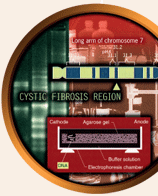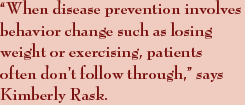|












|
 |
| |
|
|
|
|
 |
 E-mail to a Friend
E-mail to a Friend
 Printer Friendly
Printer Friendly |
 |
| |
 |
|
 |
|
 |
Ponce
may have gone home empty-handed, but scientists today believe a
fountain of youth may exist. Not as an external body of water, but
as a biological capability within each person. In our genetic code,
they say, lie the keys to ending all disease and physical suffering.
This is the promise of predictive health, an emerging paradigm that
emphasizes maintaining health by detecting the genetic risk factors
for illness and taking steps to prevent disease or illness before
it even starts.
The newly established Emory-Georgia
Tech Predictive Health Initiative is conducting some of the first
explorations in this new clinical frontier. At this early stage,
the discipline also goes by a variety of other names—systems
biology, prospective health, personalized medicine. But all of these
terms refer to the same basic thing: a gigantic shift in the way
we think about health, health care, and medicine. In the future,
providers will combine an individual’s genetic information
with cutting-edge biotechnology to keep that person healthy. Eventually,
many experts say, the occurrence of disease will be seen as a failure
of the health care system, rather than its main focus.
“There is a sea change coming,”
predicts pulmonologist Kenneth Brigham, vice chair of research in
Emory’s Department of Medicine and leader of the interdisciplinary
faculty effort that developed the new initiative. “No doubt
about it.”
|
 |
 |
Michael Johns, CEO of the Woodruff
Health Sciences Center (WHSC) and chairman of the Emory Healthcare
Board, agrees.
“The medicine of the very near
future involves the ability to rapidly decode hundreds of millions
of genome sequences and isolate the information that will tell us
about a person’s risk of future disease,” says Johns.
“We will be able to forecast the future and see where patients
stand in the trajectory of disease. Our great hope is to use the
new genetic tools being developed in bioengineering to intervene
in the disease process very early, before disease is manifest. Instead
of doctors reacting to the presence and damage of disease, we will
be in the driver’s seat. The doctors of tomorrow will have
tools at their disposal that doctors of my generation have only
dreamed of. And the hope is that patients one day will never have
to be patients at all.”
|
 |
 |
What
keeps people healthy? |
|
 |
At
an international symposium called “Seeking Ponce’s Dream:
the Promise of Predictive Health” held this past December,
Emory and Georgia Tech declared their intent to develop a world-class
center dedicated to exploring the potential of this new approach.
In many ways, the initiative is a
logical outgrowth of an already fruitful partnership between Emory
and Georgia Tech. Their joint Department of Biomedical Engineering,
formed in 1997, was ranked third in the nation in 2005 by U.S.
News & World Report. Faculty all across the WHSC already
are collaborating with Georgia Tech’s biomedical engineering
researchers on many projects, including studies of genetic and molecular
changes linked to heart disease and different types of cancer and
the development of new vaccine administration technologies.
With a projected budget of $51 million
over the next five years, the Predictive Health Initiative will
add eight more pilot research studies supported by the WHSC’s
Woodruff Fund.
One large project will examine how
common physical reactions like inflammation play a role in causing
or exacerbating different chronic conditions. Another study examines
genetic prediction of schizophrenia in children. Researchers from
the Winship Cancer Institute are studying the behavior of proteins
in tumors. And many of these studies will examine why some people
genetically predisposed to a disease never become ill.
|
 |
 |
“It’s
kind of like the dog that didn’t bark,” says Brigham.
“There’s a lot to learn from people who stay healthy
in spite of their genetics. This line of thought is completely opposed
to the way medical research has been conducted in the past, where
we have studied sick people, not healthy people. Keeping people
healthy is the focus of predictive health.”
At the same time, researchers at the
Rollins School of Public Health (RSPH) are studying the economic,
epidemiologic, and behavioral implications of the predictive health
movement. For example: What will people do with the information
about their risk factors? How should such information be responsibly
maintained and communicated? |
 |
 |
The initiative funding will support
the different research endeavors by bringing together experts from
a broad range of disciplines: computer science, nanotechnology,
basic and applied biology, medicine, ethics, sociology, public health,
business, law, and behavioral science.
Developing a new predictive health
model will require a mind-boggling mix of cutting-edge research
and new technology. And leaders must wrestle with many difficult
social and ethical issues as well. How accessible will personalized
genetic information be to those of limited financial means? What
will be the consequences for people found to be at high risk for
a particular condition or disease? Are there diseases or conditions
that we may be able to predict but not prevent? These are some of
the compelling issues posed by this new era in medicine.
“We have had vigorous and open
discussions, and the symposium was a culmination of that,”
Brigham says. “The idea of predictive health incites passions
in many different directions, including the scientific, social,
legal, economic, and health policy implications.” |
 |
| |
|
|
| |
|
|
| |
|
|
| Mapping
our inner frontiers |
|
|
 |
The
seeds of this new revolution were planted in 1953, when Cambridge
researchers James Watson and Francis Crick first described the structure
of DNA. Since the mapping of the human genome in 2003, understanding
of genes and the capacity to manipulate them have exploded. The
ability to use genetic information to predict, diagnose, and treat
a vast array of diseases in individuals grows exponentially by the
day, and rapidly improving technology and computers that can analyze
vast amounts of genetic data have created enormous potential.
Molecular biologist Lee Hood, founder
and CEO of the Institute for Systems Biology in Seattle, WA, is
a leading pioneer in this new way of looking at health and disease
prevention. He and colleagues at Caltech pioneered four instruments—the
DNA gene sequencer and synthesizer and the protein sequencer and
synthesizer—that were key to the successful mapping of the
human genome. He now envisions computer chips that can create profiles
of an individual’s disease risks based on a single blood sample.
“I predict that within 10 years,
we’ll be making billions of genetic measurements in individuals,”
said Hood, in his opening presentation at the December symposium.
“This requires biology, technology, and computational power.
Genes are complex molecular machines. They encode proteins. Gene
regulation and transcription factors can control the working of
other transcription factors. Medicine in the future will be able
to use this information to engineer disease mechanisms to make them
behave in a way to lessen disease.”
Modern molecular biology has reduced
the study of disease to Lilliputian dimensions, with the key unit
of measure a billion times smaller than a meter—the nanometer.
At this level, genes and the proteins they
produce are observed to detect subtle changes over time and variations
from person to person.
|
 |
 |
Biomedical
engineers are developing new tools to complement this new knowledge.
The term nanotechnology refers to the development of tools small
enough to latch onto genes and proteins and make them visible to
the human eye as well as able to be manipulated. For example, a
team led by Emory researchers Shuming Nie and Leland Chung have
developed specialized “quantum dots,” nanoparticles
that target specific molecules on the surface of cancer cells when
injected into the body. Eventually, the dots could be used to detect
cancerous cells at extremely early stages and deliver targeted treatments
that would eliminate the cells without damaging their healthy neighbors.
These tools and targets are 100,000 times smaller than the diameter
of a human hair. |
 |
 |
Steve Warren, chairman of Emory’s
Department of Human Genetics, says these capacities have created
new ways to think about diagnosis, therapy, and drugs. “Fifteen
years ago, we thought genetics would only help diagnose disease,”
he says. “Now we know if we delve deep enough into individual
genes, we can uncover logical interventions to prevent and treat
diseases. The entire concept of predictive medicine evolved from
the discipline of human genetics, and the concept of genomic medicine
relates to all disciplines of medicine. It is the rare and exceptional
disorder with no known genetic risk.”
The aim of predictive medicine is
to use genetic information to better understand normal biological
networks at the molecular level and then engineer or manipulate
disease mechanisms to make them behave in a way to lessen disease.
Patterns of gene expression are altered in disease. Normal protein
secretion patterns can provide “molecular blueprints”
of what healthy cells should look like, yielding new diagnostic
tests and tools. Some of these proteins also will lead to new drugs
and treatments targeted to an individual person’s genetic
makeup. |
 |
| |
|
 |
 |
| |
|
|
|
|
 |
Too
much of a good thing |
 |
 |
The
human body can take pretty good care of itself. Thanks to
the immune system, the human race has survived for millions
of years in the face of ever-present and evolving microbial
threats. When bacteria or viruses invade, white blood cells,
T-cells, and a host of other immune actors keep invaders at
bay.
But immune protection doesn’t
come without a price. Sometimes the hyper-vigilant defense
system doesn’t know when to stop. The effects can be
as benign as nagging runny noses and itchy rashes or as deadly
as anaphylactic shock or sepsis.
The swelling or inflammation that
occurs when immune cells do their duty sometimes damages the
body more than the initial threat itself, says David Stephens,
an infectious disease expert. Chronic inflammation causes
disorders like rheumatoid arthritis and Crohn’s disease
and is increasingly linked to prevalent killers like atherosclerosis,
heart disease, cancer, and Alzheimer’s.
Emory researchers are seeking
new ways to detect unhealthy inflammatory states. Stephens
is leading a cross-disciplinary study supported in part by
the Woodruff Fund. Leading immunologists including Rafi Ahmed,
director of the Emory Vaccine Center, are collaborating.
“Science is now making
a transition from looking at first-generation biomarkers for
inflammation like white count, sedimentation rate, and C-reactive protein to more
sophisticated and precise measures,” Stephens says.
“The next generation of inflammation biomarkers will
include a variety of cytokine markers for chronic infection.”
count, sedimentation rate, and C-reactive protein to more
sophisticated and precise measures,” Stephens says.
“The next generation of inflammation biomarkers will
include a variety of cytokine markers for chronic infection.”
Cytokines are immune-signaling
proteins produced by lymphocytes that accumulate where there
is chronic injury, irritation, or invasion. Stephens’
study aims to understand markers of innate immunity, or the
initial response of the host against infection, as opposed
to adaptive immunity, which teaches the body to recognize
and attack certain recurring infections. “Identifying
certain differences in these receptors that mark innate immunity
will provide clues about who will be at risk for increased
or decreased inflammatory response,” he says. |
 |
 |
|
|
|
 |
|
 |
 |
|
|
|
|
| We
are not alone |
|
 |
 |
It’s
not just the human genome we have to worry about, warns David Stephens,
director of infectious diseases in the Department of Medicine and
executive associate dean for research in the medical school. The
challenge of truly predicting what biologic changes are linked to
future disease may be much more complicated than we realize. |
 |
 |
The
human body plays host to many tiny creatures: bacteria, viruses,
and a host of other microscopic elements yet to be discovered. They
live in our guts, our hair, our skin, between our teeth, and under
our fingernails. They make us sick. They keep us well. They are
in and around us all the time, interacting with every aspect of
our being, including our genes.
“We live in a microbial world,”
he says. “There is incredible biodiversity among microbes,
and even with all the enthusiasm in the 1960s about eliminating
diseases with antibiotics, vaccines, and sanitation, new and ever-more
threatening infections are emerging all the time. Microbial mutation
and recombination occurs at an astonishing rate. Microbes are perhaps
the most adept organisms at adaptation. And most of the microbes
in the world have yet to be defined.”
|
|
 |
Stephens maintains that human genetics
and proteomics are insufficient to predict disease. The interactions
between the environment and all the other forms of life we come
in contact with have a profound effect on our bodies and our health.
To make accurate predictions about genetic disease, the genetics
of microorganisms and the way they interact with human cells must
be unraveled as well.
To illustrate his point, Stephens
describes an unintended consequence of a once highly publicized
medical breakthrough—the discovery that Helicobacter pylori
causes stomach ulcers and is linked to the development of gastric
cancer. Treatment of stomach ulcers with antibiotics has yielded
a steep decline in rates of gastric cancer. But in the decades following
wide acceptance of antibiotic treatment, a disturbing increase in
cases of esophageal cancer occurred.
Killing off H. pylori, Stephens
says, has in some way upset a delicate gastrointestinal balance
in some patients, perhaps also ridding the body of a yet-unidentified
bacteria in the esophagus that provides a protective effect. Tinkering
with the delicate balance our bodies have achieved with the microbial
world over the past million years can have many unintended consequences.
Any foray into predictive medicine
must include charting the genomes of microbes and elucidating their
interactions with human genes and proteins as well, Stephens says.
|
 |
 |
Who
will benefit? |
|
 |
As
if genes, proteins, and an invisible world of microbes were not
enough, the ethical issues surrounding predictive medicine are daunting.
Personal privacy and data security issues are just the beginning.
How a university should concentrate its resources to help humanity
get the most bang for the buck was a recurring theme at the predictive
health symposium. No punches were pulled, and the discussion was
rigorous.
Howard Kushner, who holds dual appointments
in history and public health, considers himself an applied historian
of medicine. He believes medical knowledge should be viewed in historical
and cultural perspectives. At the predictive health symposium, he
suggested committing more resources to the “bigger picture”
of health care.
“Our medical system is broken,”
he says. “In the richest country in the world, 30% of Americans
have no access to regular preventive health care. Increasingly,
we find we can’t even trust the information coming out in
medical journals. Behavioral aspects of health have not been well
studied and factored into the equation of this new predictive health
model. We already have many good health care technologies and lots
of knowledge, but they’re not effective because of noncompliance
and a lack of will to provide equity.”
Indeed, ensuring the integrity and
reliability of the information obtained will be central to the success
of predictive medicine. Storing, retrieving, and using the vast
amounts of medical data that could soon be available for every individual
will be a monumental computer science challenge, notes Kathy Kinlaw,
director of the Emory Ethics Center. To be useful for predicting
future illness, the data collected must be standardized. Physical
characteristics are deemed “normal” or “abnormal”
by comparison with population averages, she notes. Without that
information, the genome of a particular individual may not yield
much diagnostic information. The potential for human error in interpreting
genetic information must also be factored into the predictive medicine
equation.
“Once we have determined a biomarker,
will the information be specific enough to have any value?”
Kinlaw asks. “Will all patients want to know the information
and will there be therapeutic interventions to offer them once they
have this knowledge? Ethics must be a key part of this initiative
because these questions will accompany this movement all the way.” |
 |
 |
|
|
|
| |
| |
|
|
|
|
 |
Looking
at the big picture |
 |
 |
When
many people think of the future of predictive medicine, they
think of personalized treatments tailored to an individual’s
specific genetic code. But the real promise of predictive
medicine, many researchers say, lies in its potential to help
society determine the best use of limited health care resources.
“We need to know how to
find the high-risk people,” says Kimberly Rask, professor
of health policy and management at the Rollins School of Public
Health (RSPH). “It costs more to screen everyone than
it does to screen a sub-sample of people, and the number of
at-risk people identified will determine the cost-effectiveness
of screening.”
Rask and other Emory researchers
are exploring how to incorporate economics, epidemiology,
and the intricacies of human behavior into the predictive
health equation. Ongoing studies of large groups of people
at risk for Parkinson’s disease and type 2 diabetes
offer opportunities for finding new population-based strategies
for disease prediction.
prediction.
“They are both common
chronic diseases that irreversibly damage the body over time,
but effective treatments are available,” says Rask.
“Diabetes involves both behavioral and genetic risk
factors, with rising rates of obesity correlated with the
recent explosion of diabetes among Americans.”
Parkinson’s disease involves
a complex interplay between genetic and environmental factors.
A small percentage of cases occur in young people and are
thought to be purely genetic. But the majority of cases are
diagnosed in people older than 55 and probably stem from environmental
or a combination of genetic and environmental factors.
Gary Miller and Scott Bartell,
professors of environmental and occupational health at the
RSPH, are working with Emory neurologists and scientists in
the Emory/Georgia Tech Department of Biomedical Engineering
to develop a model of Parkinson’s disease based on systems
biology.
They are developing a set of
complementary computational models to seek connections between
permutations of genotypes, environmental exposures, lifestyle
factors, and the occurrence of Parkinson’s. They hope
to develop predictive algorithms to help clinicians diagnose
the disease earlier. They then can aim prevention strategies
at the populations at greatest risk. |
 |
|
 |
 |
 |
 |
Miller
says early intervention is crucial. “By the
time a patient is diagnosed with Parkinson’s,
more than 80% of the dopamine-producing neurons in
the brain have already been lost,” he says.
“This leaves only a very small window of opportunity
for interventions aimed at slowing or halting the
progression of the disease. Our computational approach
may lead to earlier detection and treatment of the
disease and possibly complete prevention.
“Many clinical
trials of drugs to treat Parkinson’s disease
have failed |
|
 |
 |
over
the past decade, possibly because the disease had progressed
too far for these drugs to be effective,” he says. “However,
some of these may work well if started earlier.” |
 |
 |
A
similar approach is being used to study diabetes. Now the
sixth leading cause of death in the United States, rates of
type 2 diabetes—the most common kind—are skyrocketing.
The Centers for Disease Control and Prevention reports that
diabetes incidence increased by 33% from 1990 to 1998. Currently,
an estimated 7% of the population has it.
Rask, who directs the Emory
Center for Health Outcomes and Quality, is studying interactions
between genetic and behavioral risk factors for diabetes.
She is analyzing data from the Third National Health and Nutrition
Examination Survey (NHANES III) as well as data from a group
of diabetes patients at Grady Memorial Hospital.
“Health outcomes studies
show that even after diagnosis many patients do not receive
recommended care for many clinical conditions,” she
says. “When disease prevention involves behavior change
such as losing weight or exercising, patients often don’t
follow through. Economic barriers to health care can also
keep patients from early diagnosis and proper follow-up treatment.”
In the Grady portion of Rask’s
work, she will collect a comprehensive set of biologic, behavioral,
and environmental risk data for health outcomes in diabetic
patients. Their health care-seeking behavior will be monitored
and correlated with behavioral and environmental factors to
find the best predictors of healthy outcomes.
“The challenges are daunting,”
Rask says. “Persuading insurance companies to cover
extensive, and perhaps expensive, predictive health testing
will be difficult. That’s why we require strong cost-effectiveness
data for predictive health models.” |
 |
| |
|
|
|
|
|
 |
 |
|
|
|
| |
|
|
|
|
 |
Finding
the method to the madness |
 |
 |
Doctors
and scientists have known for years that many mental disorders
have a strong genetic component. Population studies indicate
that people who have a family history of bipolar disorder
or schizophrenia, for example, face a higher risk of developing
the illness themselves. But researchers are only just beginning
to discover which genes and mutations are associated with
mental illness and what role environmental exposures and life
experiences might play.
Emory psychiatrist Joseph Cubells
is studying a group of children at high risk for schizophrenia
because they have a genetic condition called 22q11 deletion
syndrome (22q11DS). This syndrome arises from deletion of
some DNA from a portion of chromosome 22, resulting in only
one copy of these genes, rather than the normal two copies.
Of adults with molecularly confirmed 22q11DS, 20% to 30% meet
the standard diagnostic criteria for schizophrenia. These
percentages indicate an association between the deletion and
the disease, but not all patients with the deletion end up
with schizophrenia.
adults with molecularly confirmed 22q11DS, 20% to 30% meet
the standard diagnostic criteria for schizophrenia. These
percentages indicate an association between the deletion and
the disease, but not all patients with the deletion end up
with schizophrenia.
Cubells and coworkers are studying
a group of adolescents and children with 22q11DS, in the hopes
of identifying new behavioral and molecular predictors of
schizophrenia risk. By pairing neuropsychologic tests of cognitive
function, attention, and working memory with detection of
certain enzymes and genetic variations sometimes associated
with schizophrenia, Cubells hopes to identify sequence variants
(biomarkers) in these genes that predict whether children
with 22q11DS will develop schizophrenia.
Identifying early signs of the
illness could lead to earlier intervention with medication,
psycho-education, and other behavioral measures to slow the
progression of schizophrenia. “Complex brain disorders
like schizophrenia are usually chronic and recurrent,”
says Cubells. “As time passes, patients not only contend
with the primary symptoms of the illness, they develop coping
strategies and self-images often warped by the illness. Even
after recovery, they often have to unlearn maladaptive habits
and patterns of thinking that developed during symptomatic
periods.”
|
 |
 |
 |
Biomarkers
for mental illnesses like depression or bipolar disorder
have been elusive, but new genetic and neuroimaging
tools hold great promise. “Early detection of
mental illness through biologic markers will put to
rest the vicious myth that brain disorders are associated
with moral failure or weakness of will,” Cubells
says. “Erasing that stigma will bring us closer
to parity in insurance coverage for brain disorders
as we demonstrate that complex brain disorders are every
bit as ‘medical’ as diabetes or heart disease.”
|
|
 |
|
 |
|
|
|
 |
Will
it work? |
|
 |
| |
Jeffrey
Koplan, vice president for academic health affairs at WHSC and former
director of the U.S. Centers for Disease Control and Prevention,
concurs. At the symposium, he asked the audience whether they had
drunk clean water, worn a seatbelt, or had unprotected sex with
a stranger that morning. (RSPH Dean and HIV expert James Curran
raised his hand in jest to the last question.)
“Public health aims for the
big, quick impact health interventions can have on large populations,”
Koplan says. “I would argue that public health achievements
are the most significant medical achievements made during the past
100 years. We must ask: Will this technology be available to all?
In public health we value equity. The concerns I have are the existing
disparities in care at home and abroad, the issue of privacy, and
the problems posed by giving people disturbing information years
before they can do anything about it.”
Deryk Yach, professor of global health
at Yale School of Medicine and a native of South Africa, questioned
whether many people—given information about future disease
risk—would still follow through with the necessary steps to
prevent disease.
“Strong economic forces are
driving global changes in health and culture,” he says. “The
countries that are experiencing the most rapid income increases
also are having increasing levels of cholesterol and body mass index.
And we have no example in the world—no success story—where
rising obesity has been reversed in the population. This leads to
an old age full of disability and disease, with low quality of life.”
Yach says that along with more economic
opportunity, the developing world is importing risky behaviors from
the West, such as smoking and high-fat, high-sugar diets. “Yet
levels of hunger and underweight are at 50% in many parts of Africa
and Southeast Asia, and life expectancy has been declining among
Russian men,” he says. “I think that the current obesity
epidemic in the western world has affirmed the theory of flawed
self assessments. We know what to do to stay healthy, yet we always
fail to do what’s best for us.”
He also issued a grave warning about
creating vast databanks of predictive health information. “I
have no doubt that insurance agencies will cherry pick at the highest
levels when we get such data.”
The Emory/Georgia Tech Predictive
Health Institute must help society face these challenges in the
new age of medicine that is coming, whether we like it or not, says
Johns. In fact, academic institutions are the best places to make
sure ethical and public health implications are integrated into
the practice of this “new medicine.”
U.S. government health officials recognize
this coming “sea change” but acknowledge that dealing
with it will take time and political willpower. Currently, the U.S.
Senate has twice passed a genetics discrimination bill, and the
House of Representatives has refused to pick it up.
Johns acknowledged the difficulty
and complexity of the task ahead. “The work ahead of us is
monumental but of crucial importance for the world,” he says.
“We aim to be among the premier universities, and we must
be up
for this challenge.”
Valerie Gregg is a freelance writer in Atlanta. |
 |
| |
|
|
|
|
| |
 |
 |
Exploring the cancer connection
Predictive medicine
is also the focus of a new federally funded initiative at
Emory’s Winship Cancer Institute.
Scientists
at Emory and Georgia Tech are working in tandem to develop
nanotechnology tools to detect and manipulate cancer at the
molecular level. Their efforts recently earned them status
as one of eight National Centers of Cancer Nanotechnology
Excellence (CCNE) designated by the National Cancer Institute.
This award carries nearly $27 million in federal and state
funding over the next five years. |
 |
 |
 |
|
 |
 |
The
grant created a new center called the Emory-Georgia Tech Nanotechnology
Center for Personalized and Predictive Oncology. Housed at
both Winship and Tech, the center aims to integrate nanotechnology
into personalized cancer treatments and early detection and
deliver these tools to patients within the next decade. The
joint Department of Biomedical Engineering at Georgia Tech
and Emory, established in 1997, was a key factor in gaining the
CCNE designation.
Emory, established in 1997, was a key factor in gaining the
CCNE designation.
The CCNE’s director and
principal investigator is Shuming Nie, the Wallace H. Coulter
Distinguished Chair and Professor. Nie’s work involves
both quantum dots and raman tags, computer chips so tiny that
they can attach themselves to the proteins produced by certain
genetic changes. With new digital imaging technology, these
chips can identify the markers of genetic change and make
them visible to the human eye. Along with biomedical engineer
Gang Bao and others, Nie plans to create particles that can
zoom in on pre-cancerous cells and ultimately deliver targeted
therapeutics to halt the genetic changes that lead to cancer.
The Emory/Georgia Tech collaboration
is one of the largest federally funded programs in biomedical
nanotechnology, biomolecular and cellular engineering, cancer
bioinformatics and biocomputing, and translational cancer
research. The CCNE now encompasses six projects with five
core areas of study. Other current projects include
|
 |
 |
- Development
of tumor-targeted infrared quantum dots with optical and
magnetic imaging capabilities.
- “Smart”
nanoparticle probes for intracellular drug delivery and
gene expression
imaging.
- Antibody-conjugated
quantum dots to detect and quantify human breast cancer
biomarkers.
- Nanoparticle
tags for tracking multiple biomarkers in biologic specimens
using surface-enhanced raman spectroscopy.
- Nanoparticles
to deliver therapeutics to bone metastases.
|
 |
 |
“We
have a truly collaborative environment for research to help
translate biomedical engineering discoveries into clinical
medicine,” says Nie. “This center will help cancer
patients all over
the world.” |
 |
| |
|
|
|
 |
| |
|
|
|
|
| |
|
|
|
|
|
|

